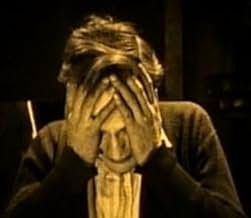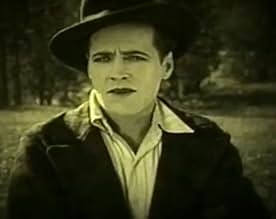Adicionar um enredo no seu idiomaAfter wolf blood transfusion, man thinks he's becoming a wolf.After wolf blood transfusion, man thinks he's becoming a wolf.After wolf blood transfusion, man thinks he's becoming a wolf.
- Direção
- Roteiristas
- Artistas
- Direção
- Roteiristas
- Elenco e equipe completos
- Produção, bilheteria e muito mais no IMDbPro
Avaliações em destaque
Despite the title, this isn't a horror film at all; the werewolf elements are only introduced three-quarters of the way in which are, in any case, merely suggested through the lead character's hallucinations but these obviously constitute the film's highlight (though rugged, pasty-faced star and co-director Chesebro isn't exactly Lon Chaney Jr.); still, the transformation-by-transfusion is an interesting concept, one which I don't think has been done in subsequent films. However, while the forest locations are certainly nice, the unexciting main narrative involving rival logging companies and the unavoidable love triangle really drown the interest; a subplot involves a villainous moonshiner who's a dead ringer for Walter Brennan and, for the record, there's even an interminable "Jazz Age" party sequence towards the beginning! The soundtrack accompanying the print I watched features a classical piece which was also used to much greater effect in Luis Bunuel's L'AGE D'OR (1930).
A nascent werewolf picture which, despite its promising premise, carefully avoids a descent into lycanthropy, this "tale of the forest" will disappoint most horror fans. However, it does have other points of interest including its attractively tinted location photography and its fascinating cast headed by the famous silent star, the charming Marguerite Clayton, here nearing the end of her 180-movies career!
Doubtless for reasons of economy, George Chesebro was handed the reins to direct many of his own scenes. Unfortunately, he opted to adopt the clownish make-up he sported in the 1920 serial, "The Lost City", and he looks a real sight with his ghost-white face, black-rimmed eyes and painted smile. And this is before he thinks he might turn into a werewolf!
Chesebro is joined by his sidekick pal from "The Lost City", Frank Clark, but it's prolific character actor Milburn Morante who easily steals this picture from both of them.
The scenes directed by Bruce Mitchell are much smoother and far more natural than the Chesebro footage. And in his delightfully foot-tapping, jazz party sequence, the beautifully tinted images often give the lustrous impression of early two-strip Technicolor.
Doubtless for reasons of economy, George Chesebro was handed the reins to direct many of his own scenes. Unfortunately, he opted to adopt the clownish make-up he sported in the 1920 serial, "The Lost City", and he looks a real sight with his ghost-white face, black-rimmed eyes and painted smile. And this is before he thinks he might turn into a werewolf!
Chesebro is joined by his sidekick pal from "The Lost City", Frank Clark, but it's prolific character actor Milburn Morante who easily steals this picture from both of them.
The scenes directed by Bruce Mitchell are much smoother and far more natural than the Chesebro footage. And in his delightfully foot-tapping, jazz party sequence, the beautifully tinted images often give the lustrous impression of early two-strip Technicolor.
Wolf Blood (1925) is NOT the first werewolf film - that title goes to Universal's long lost film "The Werewolf" (1913). BUT it might be fair to say that Wolf Blood (1925) is the first surviving film concerning lycanthropy and second werewolf film made.
Fun note: It is said that most film historians say that it is Universal's "Werewolf of London" (1935) that is the first werewolf film - yet we have "Wolf Blood (1925) that deals with the subject and before that the long lost film "The Werewolf" (1913).
My problem with Wolf Blood (1925) is that they took too much time to get to the point - it took the first 35 minutes (out of 107 minutes) to get to our "werewolf". We did not need 35 minutes worth of background on "romance" and two rival logging companies because the film's focus is suppose to be on the wolf's blood in the man's veins. We really only needed about 10 to 15 minutes for the background NOT 35 minutes worth - they could have used the extra time to build suspense surrounding the wolf's blood in the man's vein and how it was effecting him psychologically, local superstitions concerning werewolves etc.
Now once we finally got to our "werewolf" the film was pretty good.... just not enough focus on the reason people would want to see the film: lycanthropy - even if it is only in a person's mind.
The movie is however worth watching just because it is the first surviving film on the subject and the second film ever made about it. I do not consider this a horror film - just a drama.
6/10
Fun note: It is said that most film historians say that it is Universal's "Werewolf of London" (1935) that is the first werewolf film - yet we have "Wolf Blood (1925) that deals with the subject and before that the long lost film "The Werewolf" (1913).
My problem with Wolf Blood (1925) is that they took too much time to get to the point - it took the first 35 minutes (out of 107 minutes) to get to our "werewolf". We did not need 35 minutes worth of background on "romance" and two rival logging companies because the film's focus is suppose to be on the wolf's blood in the man's veins. We really only needed about 10 to 15 minutes for the background NOT 35 minutes worth - they could have used the extra time to build suspense surrounding the wolf's blood in the man's vein and how it was effecting him psychologically, local superstitions concerning werewolves etc.
Now once we finally got to our "werewolf" the film was pretty good.... just not enough focus on the reason people would want to see the film: lycanthropy - even if it is only in a person's mind.
The movie is however worth watching just because it is the first surviving film on the subject and the second film ever made about it. I do not consider this a horror film - just a drama.
6/10
Wolf Blood (1925)
** (out of 4)
In the Canadian wilderness, a logger is injured and near death when a doctor gives him a blood transfusion from a wolf. The man eventually lives but soon he begins to fear he's turning into a wolf. Well, I guess Werewolf of London wasn't the first "werewolf" movie. There aren't any transformation scenes here but it's very clear to see that the final fifteen minutes of this influenced the screenplay of The Wolf Man. The film runs a quick 68-minutes but the wolf action really doesn't start until the very end. Up until that point, we've got a pretty over-dramatic love story that doesn't work at all. None of the actors are that interesting and the technical style looks like 1910 and not what we'd expect from 1925. Those interested in the wolf aspect might want to check it out for a historical purpose but others stay clear.
** (out of 4)
In the Canadian wilderness, a logger is injured and near death when a doctor gives him a blood transfusion from a wolf. The man eventually lives but soon he begins to fear he's turning into a wolf. Well, I guess Werewolf of London wasn't the first "werewolf" movie. There aren't any transformation scenes here but it's very clear to see that the final fifteen minutes of this influenced the screenplay of The Wolf Man. The film runs a quick 68-minutes but the wolf action really doesn't start until the very end. Up until that point, we've got a pretty over-dramatic love story that doesn't work at all. None of the actors are that interesting and the technical style looks like 1910 and not what we'd expect from 1925. Those interested in the wolf aspect might want to check it out for a historical purpose but others stay clear.
Half the film involves trees falling down and the same stock footage of the lumber industry. There are two warring camps. One is sending men to shoot the workers in the other camp. It is getting ugly. There are so many injuries that the foreman (a sort of Nelson Eddy kind of guy) gets in touch with the owner (who happens to be a rich flapper, engaged to a surgeon). She goes to the camp with her fiancé. He will do the doctoring while she assesses the situation. There is no reason for her to be there other than to advance the plot and get her to fall in love with the handsome foreman. At some point, the guy (who acts before thinking) finds that the opposing camp is about to dam up the river and ruin their business. After a confrontation with a couple of lumberjacks, he is knocked unconscious and thrown in a ravine. He is later found by the surgeon who is put in a position of using wolf blood to save his life. Of course, he now begins to act wolf-like. Some say this was the first werewolf movie. There are some fun moments, but, over all, it is just quite moronic.
Você sabia?
- CuriosidadesAs of this writing, this is the oldest existing werewolf film.
- ConexõesReferenced in Doomed: The Untold Story of Roger Corman's the Fantastic Four (2015)
Principais escolhas
Faça login para avaliar e ver a lista de recomendações personalizadas
Detalhes
- Tempo de duração
- 1 h 8 min(68 min)
- Mixagem de som
- Proporção
- 1.33 : 1
Contribua para esta página
Sugerir uma alteração ou adicionar conteúdo ausente






















